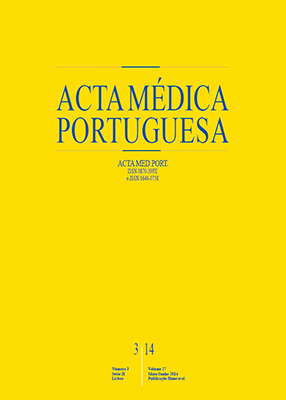Hyperplastic Polyp? Look Again... The Impact of the New Classification for Serrated Polyps
DOI:
https://doi.org/10.20344/amp.4725Abstract
Introduction: The World Health Organization reviewed the classification for serrated colonic polyps in 2010. A new entity, sessile serrated adenoma, was included with two variants: with and without cytological dysplasia. This lesion’s malignant potential has been recognized and according to the new classification, many polyps may be reclassified. The impact of this change is yet to be assessed.
Objective: Analyze the proportion of lesions that were reclassified according to the new World Health Organization classification and the variables that influenced it.
Material and Methods: Every patient with at least one sessile serrated adenoma diagnosed in a 5 year period was included. All polyps (regardless of type) resected during the study period were reviewed. Data concerning polyp’s characteristics and patient variables were collected. Forty consecutive patients were included [13 female, mean age at 1st sessile serrated adenoma -59 yrs (34-80)].
Results: Were reviewed 247 polyps: hyperplastic - 42%; conventional adenomas - 29%; sessile serrated adenoma - 24%; serrated adenomas - 5%. Sixty-three polyps were reclassified: 43 hyperplastic, 12 serrated adenomas, 7 sessile serrated adenoma and 1 conventional adenoma with low grade dysplasia. Reclassification was significantly greater for hyperplastic polyps when compared with the other subtypes. Forty-three of one hundred and four (41%) hyperplastic polyps were reclassified all as sessile serrated adenoma. In these polyps the probability of reclassification was independent from polyp location but was greater if polyp size ≥ 5 mm.
Discussion: This is a single center, rectrospective study. The fact that it was done in an Oncology Referral Institution with a Family Risk Clinic may have influenced the results. Nevertheless the impressive reclassification rate for Hyperplastic Polyps and the fact that they were reclassified mainly as Serrated Adenomas makes these results relevant to daily practice.
Conclusion: Our results suggest that, according to the new World Health Organization classification for serrated colonic polyps, a considerable proportion of hyperplastic polyps will be reclassified. The serrated pathway of colorectal carcinogenesis has probably been underestimated and at-risk patients may have been under inappropriate surveillance.
Keywords: Colonic Neoplasms/diagnosis; Colonic Polyps/classification; World Health Organization; Neoplasm Grading.
Downloads
Downloads
Published
How to Cite
Issue
Section
License
All the articles published in the AMP are open access and comply with the requirements of funding agencies or academic institutions. The AMP is governed by the terms of the Creative Commons ‘Attribution – Non-Commercial Use - (CC-BY-NC)’ license, regarding the use by third parties.
It is the author’s responsibility to obtain approval for the reproduction of figures, tables, etc. from other publications.
Upon acceptance of an article for publication, the authors will be asked to complete the ICMJE “Copyright Liability and Copyright Sharing Statement “(http://www.actamedicaportuguesa.com/info/AMP-NormasPublicacao.pdf) and the “Declaration of Potential Conflicts of Interest” (http:// www.icmje.org/conflicts-of-interest). An e-mail will be sent to the corresponding author to acknowledge receipt of the manuscript.
After publication, the authors are authorised to make their articles available in repositories of their institutions of origin, as long as they always mention where they were published and according to the Creative Commons license.









